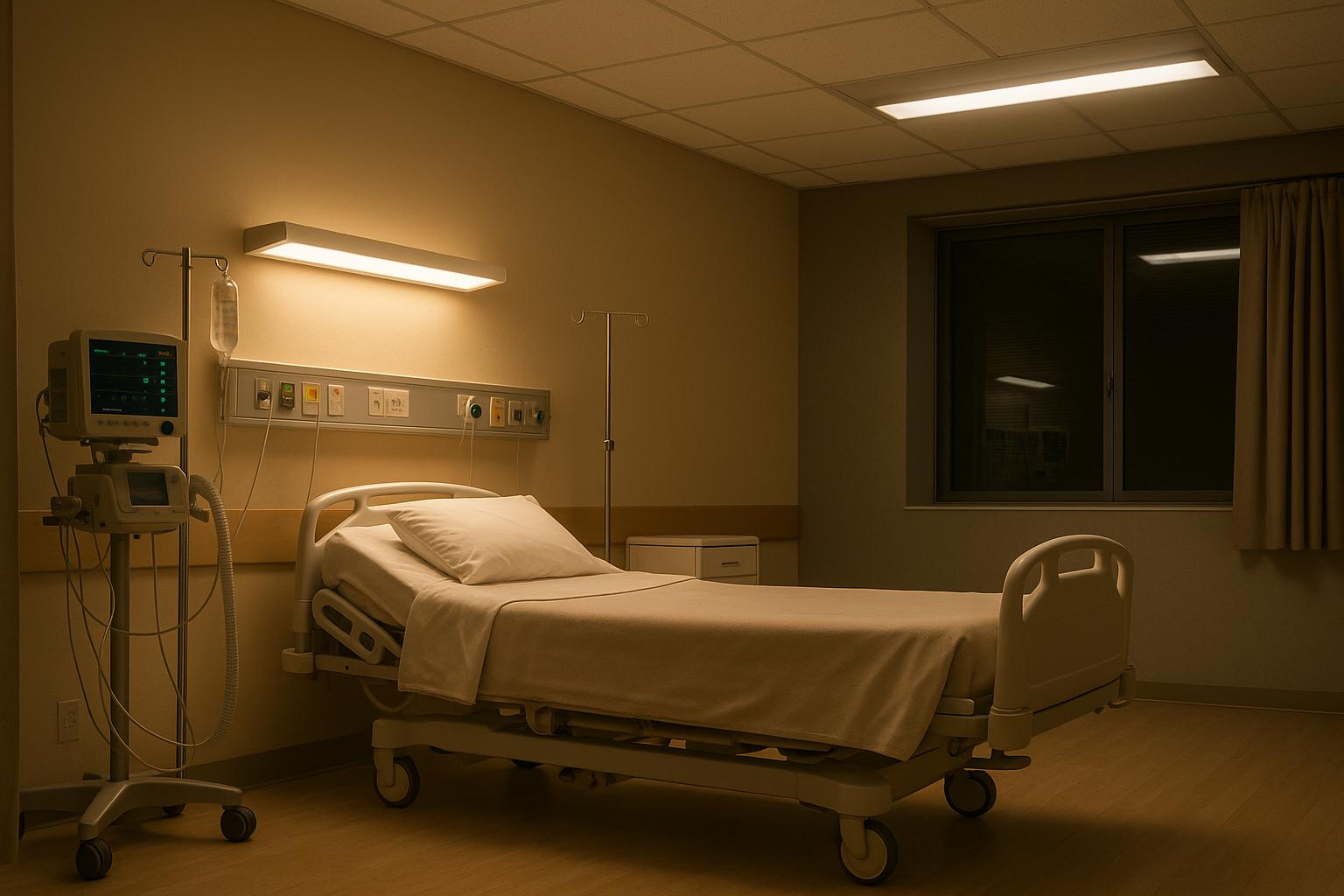LED lighting outperforms fluorescent options in hospitals, enhancing patient care, reducing costs, and improving safety and efficiency.


Lighting in hospitals isn’t just about visibility - it impacts patient recovery, staff efficiency, and long-term costs. Between fluorescent and LED lighting, LEDs are the clear winner for healthcare settings. Here’s why:
| Feature | Fluorescent | LED |
|---|---|---|
| Energy Efficiency | Standard baseline | 25–44% more efficient |
| Lifespan | 10,000–30,000 hours | 50,000–100,000 hours |
| Hazardous Materials | Contains mercury | Mercury-free |
| Light Quality | Partial spectrum, flickers | Full-spectrum, steady |
| Annual Energy Savings | - | $25,000–$44,000 per $100K spent |
Switching to LEDs improves lighting quality, reduces costs, and enhances safety, making them the smarter choice for hospitals.

Hospitals never close their doors, which means lighting is a constant drain on energy and a significant contributor to operating costs. A closer look shows that LED lighting is far superior to fluorescent options when it comes to energy efficiency and long-term savings.
LEDs leave fluorescent lighting in the dust when it comes to energy efficiency. At 100 lumens per watt, LEDs are 25% to 44% more efficient than the best fluorescent fixtures and nearly 200% more efficient than compact fluorescent lamps (CFLs).
This efficiency advantage is especially important in hospitals, where lights are on around the clock. Plus, LEDs produce less heat compared to fluorescent lights, which reduces the strain on air conditioning systems. For hospitals, where maintaining a comfortable environment is critical for patient care, this is an added bonus that further cuts energy costs.
"Upgrading to energy-efficient LED lighting is one of the fastest ways to lower operating costs. Many of our clients see energy reductions of 50–80%, along with improved light quality, reduced maintenance, and better workplace safety." - Luminate Lighting Group
Pairing LEDs with advanced technologies like dimming, occupancy sensors, and daylight harvesting can push energy savings even further. These combined benefits make a strong case for the financial and operational advantages of LED lighting in healthcare settings.
The financial perks of LEDs go beyond energy savings. While the upfront cost of LEDs is higher, their long-term ownership costs are significantly lower due to reduced energy use and minimal maintenance needs. For instance, a hospital spending $100,000 annually on lighting could slash that expense by $25,000 to $44,000 per year by switching to LEDs.
| Cost Factor | Fluorescent | LED |
|---|---|---|
| Initial Purchase Cost | Lower | Higher (but decreasing) |
| Energy Efficiency | Standard baseline | 25–44% more efficient |
| Annual Energy Savings | - | $25,000–$44,000 per $100K spent |
| Lifespan | 10,000–30,000 hours | 50,000–100,000 hours |
| 10-Year Total Cost | Higher | Lower due to energy/maintenance savings |
LED retrofits can also qualify for utility rebates and the 179D tax deduction, which help reduce the payback period for the initial investment.
In a hospital that operates 24/7, an LED fixture rated for 100,000 hours can last over 11 years before needing replacement. This longevity not only saves on material costs but also reduces labor expenses. With documented energy reductions of 25% to 47% in healthcare facilities, the efficiency of LEDs clearly translates into meaningful cost savings for hospital operations.
When it comes to long-term cost management in hospitals, durability and maintenance play a crucial role alongside energy savings. Given that hospitals operate 24/7, the reliability and upkeep of lighting systems can significantly influence operational budgets. The contrast between fluorescent and LED lighting becomes particularly evident when considering their longevity and maintenance needs.
LED lights have an impressive lifespan, typically lasting between 50,000 and 100,000 hours. In comparison, fluorescent lights operate for only 15,000 to 25,000 hours. For a hospital running non-stop, this means LEDs require replacement every 5.7 to 11 years, while fluorescent bulbs need changing every 1.7 to 2.8 years.
LEDs also outperform fluorescents in terms of durability. They’re more resistant to shock and vibration, making them ideal for high-activity areas like emergency rooms and surgical suites. Unlike fluorescent tubes, which tend to flicker and degrade over time, LEDs maintain consistent performance. This reliability is particularly critical in imaging rooms like MRI or CT scan suites, where downtime can cost thousands of dollars per hour.
This extended lifespan and durability directly reduce the need for frequent maintenance.
Fewer replacements mean lower labor costs and fewer interruptions, especially in patient care areas. Fluorescent lights, with their shorter lifespan, require frequent replacements, which not only increase labor expenses but also disrupt operations in sensitive environments. Moreover, fluorescent tubes contain mercury, a hazardous material that demands careful handling, storage, and disposal to meet regulatory standards, further adding to maintenance complexity and costs.
In contrast, LEDs are mercury-free, simplifying disposal and eliminating the need for specialized waste procedures. Their longer lifespan also minimizes disruptions in critical areas like operating rooms and patient wards.
| Maintenance Factor | Fluorescent | LED |
|---|---|---|
| Replacement Frequency | Every 1.7–2.8 years | Every 5.7–11 years |
| Hazardous Materials | Contains mercury | Mercury-free |
| Disposal Requirements | Hazardous waste procedures | Standard waste disposal |
| Light Quality Over Time | Degrades, flickers | Consistent throughout life |
| Shock/Vibration Resistance | Low | High |
"Our solutions are designed not only to improve visibility and safety but also to reduce energy consumption, lower maintenance costs, and create sustainable spaces that enhance productivity and overall facility performance." - Luminate Lighting Group
For hospitals looking to optimize their maintenance budgets, the reduced frequency of replacements and associated costs with LEDs allows for better allocation of resources. This means more attention can be directed toward improving patient care and upgrading facilities, rather than dealing with constant lighting replacements.
The type of lighting used in healthcare settings does more than just illuminate spaces - it directly impacts patient well-being and the accuracy of medical diagnoses. Comparing fluorescent and LED lighting highlights how these choices influence both patient comfort and clinical precision.
When it comes to medical environments, color accuracy is critical. LED lighting typically achieves a Color Rendering Index (CRI) of 80–95+, while most fluorescent lights fall between 70–85. This gap matters because high-CRI lighting allows medical staff to detect subtle changes in skin tone, identify rashes, or assess blood oxygenation levels with greater reliability. These details are often crucial for accurate diagnoses. Unlike fluorescent lights, which degrade over time, LEDs maintain consistent color quality throughout their lifespan.
In areas like operating rooms, emergency departments, and diagnostic labs - where precision is non-negotiable - LEDs with a CRI of 90+ can make a meaningful difference. Hospitals prioritizing diagnostic accuracy often specify these high-CRI LEDs to enhance patient safety and reduce diagnostic errors.
Lighting quality also plays a big role in patient comfort and recovery. LEDs stand out by offering flicker-free illumination and reduced glare, unlike fluorescent lights, which are more prone to flickering and can cause headaches or discomfort. Moreover, tunable LED systems can mimic natural daylight cycles, which help maintain healthy circadian rhythms. In contrast, the limited spectral range of fluorescents may disrupt sleep patterns.
Studies show that cooler color temperatures (around 6,500K) from LEDs can reduce mental fatigue and improve task performance. For instance, research from the University of Michigan revealed that switching to LEDs not only boosted energy efficiency by 44% but also delivered better light quality.
| Light Quality Factor | LED Lighting | Fluorescent Lighting |
|---|---|---|
| Color Rendering (CRI) | 80–98 (often >90) | 60–85 |
| Flicker | Minimal to none | Noticeable |
| Spectrum Coverage | Nearly full spectrum | Partial spectrum |
| Color Temperature Control | Tunable throughout the day | Fixed |
| Circadian Support | Excellent with tunable options | Limited |
Tunable LED systems take patient care a step further. Hospitals can adjust color temperatures throughout the day, offering energizing daylight tones in the morning and warmer, dimmer lighting in the evening. This approach promotes natural melatonin production, aiding sleep and recovery. Studies have even linked such lighting strategies to reduced delirium and better recovery outcomes in hospital settings.
Additionally, advanced LED systems with networked controls can reduce lighting energy use by an average of 47% in healthcare environments, all while improving patient comfort. For hospitals aiming to enhance patient-centered care, LEDs provide the dual benefit of precise, reliable lighting for clinical tasks and a more comfortable, healing environment for patients.
Switching to LED lighting isn’t just about better energy efficiency and longevity - it’s also about ensuring the transition happens smoothly, especially in sensitive environments like hospitals. The retrofit process is designed to deliver these benefits with minimal disruption to daily operations, particularly patient care.
Hospitals have three main options for retrofitting fluorescent fixtures with LEDs. Each method varies in terms of time, complexity, and impact on operations:
| Retrofit Method | Time Per Fixture | Downtime Impact | Control Compatibility | Typical Cost |
|---|---|---|---|---|
| Lamp Replacement | Under 10 minutes | Minimal | Limited (depends on ballast) | $15–$30 |
| Ballast Bypass | 20–30 minutes | Moderate (requires wiring) | Full (supports advanced controls) | $30–$60 |
| Fixture Replacement | 30–60 minutes | Highest (more labor) | Full (best for automation) | $100–$250 |
All retrofits must adhere to the National Electrical Code (NEC), local building regulations, and healthcare-specific standards. To ensure safety and compliance, work areas should be isolated, certified electricians should handle installations, and fluorescent lamps containing mercury must be disposed of properly.
"Our licensed electricians ensure full code compliance and minimal disruption to your operations", says Luminate Lighting Group.
After the physical upgrades, advanced lighting controls can further enhance energy efficiency and operational performance.
LED lighting systems bring the added advantage of networked controls, which can automate tasks like dimming, scheduling, occupancy sensing, and even daylight harvesting. According to a 2017 DesignLights Consortium report, these systems can boost lighting energy savings by an average of 47% when paired with LEDs.
These advanced controls not only save energy but also make maintenance more efficient. By integrating with building management systems, facilities managers can monitor energy use in real time, receive alerts for fixture maintenance, and schedule repairs during non-peak hours. This kind of proactive management ensures smooth operations and maximizes the benefits of LED lighting.
Hospitals that invest in LED retrofits and advanced controls typically see payback periods of 2–5 years, thanks to the significant reduction in energy and maintenance costs.
For hospitals looking to streamline the process, working with experts like Luminate Lighting Group can make all the difference. These specialists handle everything from energy audits and custom lighting designs to securing utility rebates and tax incentives - all while ensuring compliance with regulations and minimizing disruptions. With these comprehensive solutions, LEDs remain the ideal choice for hospital lighting systems.
When weighing the technical, financial, and clinical aspects discussed earlier, it’s clear that LEDs stand out as the best option for hospital lighting. Their long-term benefits go beyond just cost savings - they directly enhance your facility's operations, patient care, and overall efficiency.
Energy efficiency and total cost of ownership make LEDs a standout choice, even if their upfront cost is higher. LEDs deliver an impressive 100 lumens per watt, making them up to 44% more efficient than fluorescent lighting, according to studies. For hospitals that operate 24/7, this translates into noticeable reductions in utility bills. While fluorescents may seem like a cheaper option initially, their frequent replacements, higher energy usage, and maintenance needs make them a more expensive choice in the long run. LEDs, with their extended lifespan, significantly cut down on replacement costs and minimize the labor disruptions caused by maintenance.
Patient care quality also benefits from LED lighting. LEDs emit nearly full-spectrum light, closely resembling natural daylight. This supports accurate medical diagnosis and helps patients maintain healthy sleep patterns, which are vital for recovery. In contrast, fluorescents provide only partial-spectrum lighting, which can compromise color accuracy during procedures and disrupt patients’ circadian rhythms.
Safety is another area where LEDs have the edge. Unlike fluorescents, which contain mercury and pose disposal challenges along with health risks, LEDs are free of hazardous materials. Additionally, they provide flicker-free illumination, reducing headaches and eye strain for both patients and staff.
To transition to LEDs effectively, start with a comprehensive lighting audit to evaluate your current system and identify areas that need immediate attention. Plan for a phased implementation, scheduling upgrades during low-occupancy times to avoid disruptions. Partnering with specialized providers who understand the unique demands of healthcare lighting can simplify the process, especially when it comes to securing utility rebates and tax incentives.
"Many of our clients see energy reductions of 50–80%, along with improved light quality, reduced maintenance, and better workplace safety", says Luminate Lighting Group.
Financial incentives further enhance the appeal of LED upgrades. Hospitals can take advantage of utility rebates, federal tax deductions like Section 179D, and local energy-efficiency programs to lower the overall cost of these projects. Providers like Luminate Lighting Group can guide you through the process of identifying and applying for these incentives, helping to reduce upfront expenses and shorten payback periods.
Additionally, integrating networked lighting controls can boost energy savings by an extra 47% beyond the LED upgrade itself. These systems enable features like occupancy-based dimming, daylight harvesting, and tailored lighting programs that align with specific medical needs while optimizing energy use.
Hospitals can save a lot of money by switching from fluorescent lighting to LEDs. LEDs are far more energy-efficient, cutting energy use by 50–80%, which leads to noticeable reductions in utility costs. Plus, LEDs last much longer than fluorescent bulbs, meaning fewer replacements and lower maintenance expenses.
Beyond the financial benefits, upgrading to LED lighting improves the overall environment. The better light quality creates a more welcoming and comfortable space for both patients and staff. At the same time, this shift supports sustainability efforts by significantly lowering energy consumption.
LED lighting brings a host of benefits to hospital settings, especially when it comes to improving patient care and maintaining safety. For starters, LEDs deliver high-quality light that creates a more soothing and comfortable environment. This can play a role in helping patients feel more at ease, which may contribute to their recovery by reducing stress. Plus, since LEDs emit less heat than fluorescent lights, they help keep room temperatures steady and comfortable.
On the safety side, LEDs stand out as flicker-free and produce very little glare. This reduces eye strain for both patients and healthcare staff, making the environment more pleasant and functional. Another big advantage is their durability - LEDs last much longer and need less maintenance, ensuring that critical areas stay properly lit without constant interruptions. These features make LED lighting a smart option for supporting patient comfort while boosting efficiency in healthcare settings.
Hospitals looking to upgrade to LED lighting can benefit greatly from a turnkey LED retrofit solution. This all-in-one approach covers everything from professional lighting design to installation by licensed electricians, ensuring the project meets energy codes and regulations. By scheduling work in phases or during quieter times, hospitals can limit disruptions to their day-to-day operations.
Collaborating with specialists who provide free lighting assessments can be a game-changer. These assessments help pinpoint inefficiencies and create a customized plan that fits the hospital's needs. Plus, tapping into available rebates and tax incentives can significantly lower initial costs, making the switch to LED lighting an even smarter investment.